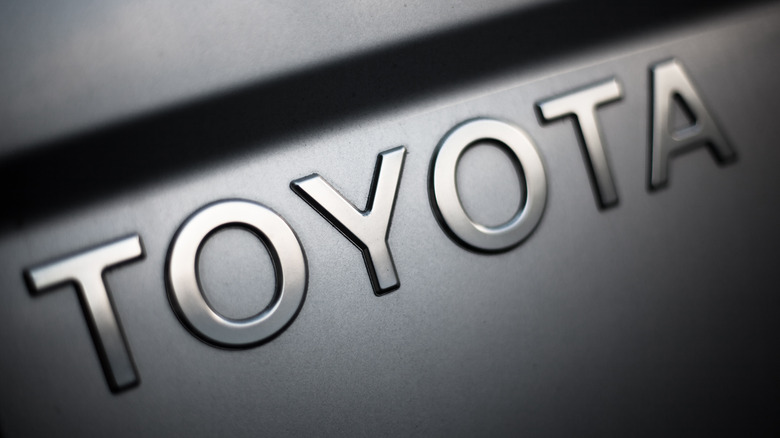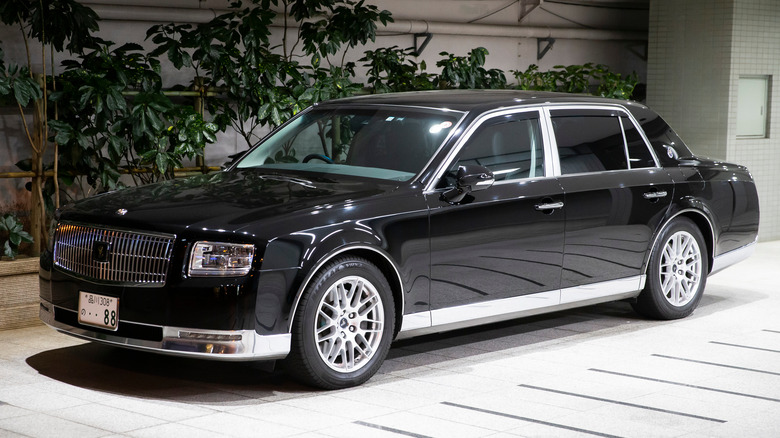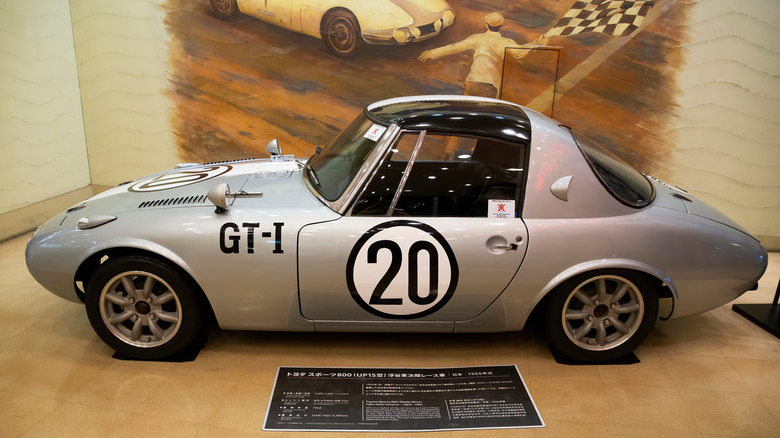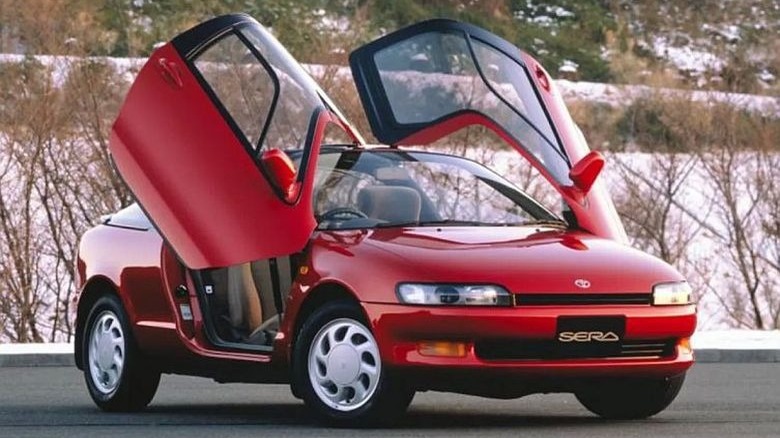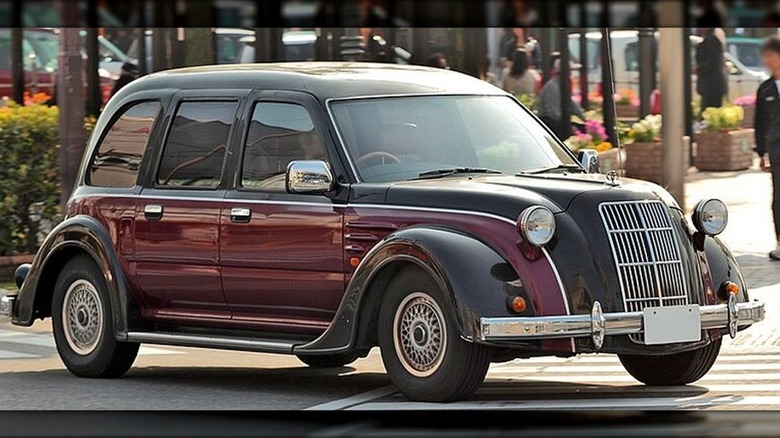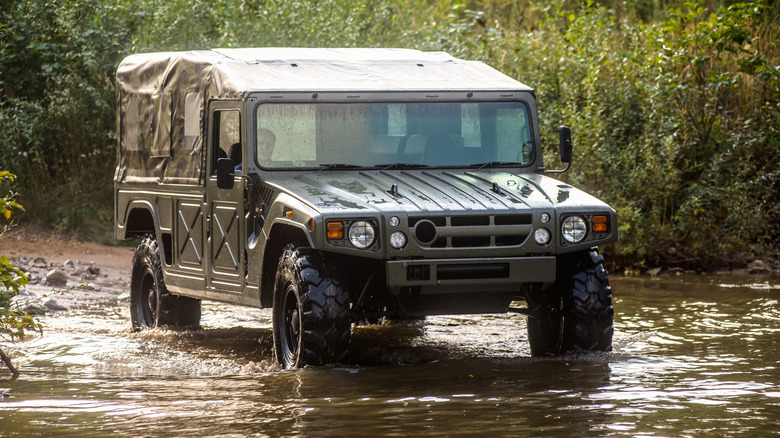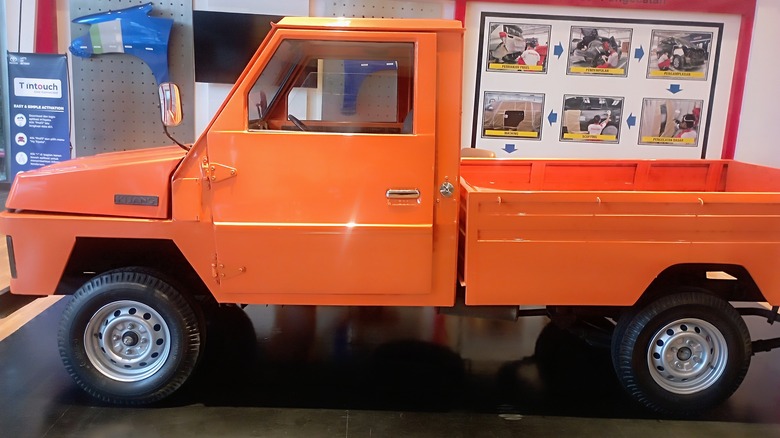6 Interesting Toyota Models That Never Made It To The US
Toyota Motor Corporation (TMC) only sold 288 automobiles (287 Toyopets and a single Land Cruiser) during its first year of production in 1958. Today, it's the world's top-selling automaker. In 2022 alone, it reported sales of over 10.5 million vehicles globally, and during the first six months of 2023, it sold 4.9 million cars worldwide (not including subsidiaries Daihatsu Motor Co., Ltd. and Hino Motors, Ltd.).
By comparison, it sold only 878,215 vehicles inside Japan during that same six-month period, equating to just 17.78% of its Japanese Domestic Market (JDM) sales. Yet, Toyota and other Japanese automakers continue to make a plethora of vehicles that never get exported to the United States and are made specifically for different parts of the world.
Remember that once a vehicle is at least 25 years old, it can be imported into the United States (whether or not it follows Federal Motor Vehicle Safety Standards). While still quite unlikely, it's not out of the realm of possibility to see any one of these cars on our list cruising American streets.
Century
The Century first debuted in 1967 and was named to honor the 100-year birthday of Sakichi Toyoda, who founded the Toyota Industries Corporation in 1926 to build and sell — not cars, but automatic looms.
Toyota made the high-end luxury car around traditional Japanese "conservative yet stately" values. Everything was automated; it had a big OHV V8 and was Japan's first passenger car equipped with air suspension. In October 1989, a limousine version was released with an extended wheelbase, longer cabin, and a glass partition that separated the driver from the passenger compartment. Additionally, the rear doors were widened, and the floor dropped to allow passengers to exit and enter the vehicle more easily.
The second generation Century was released in 1997, with upgraded components that had gotten stale after 30 years, including an electronically controlled Skyhook air suspension system. This new Century was powered by a DOHC 5.0-liter V12 (the first in a Japanese passenger car), and a compressed natural gas (CNG) version was released in January 2003.
To compete with Bentley and Rolls-Royce, Toyota made the Century with some very high-end features. Instead of a leather interior (which was an option), it came in wool as it was thought to be more elegant because it's not as "noisy and obnoxious" as leather. Each car was individually hand-painted and required 15 hours of woodworking to hand-cut and hand-sand the interior wood panels. It took 45 days just to carve out the die for the hood ornament.
Between the cost ($180,000 per car) and the hours needed to make them, the Century (and its newer luxury SUV counterpart) is reserved for the likes of Japan's royal family, who reportedly owns five customized versions of the luxury limo.
Sports 800
The Sports 800 was Toyota's first two-seat sports car. It was derived from the company's Publica Sports concept car first shown at the Tokyo Motor Show in 1962, which was quite different from the production version it began selling in 1965 for just $1,653.
The concept was designed by a team led by Tatsuo Hasegawa, who worked in the aircraft industry until World War II ended. As such, the car had no doors and a slide-back roof, a design you'd find on a fighter plane. While it was incredibly cool, it was hardly practical. When production began in '65, it did away with the sliding roof and instead featured a detachable targa-style roof that hit markets several months before Porsche, making it the first production car with one.
The aerodynamic body helped the Sports 800 get nearly 73 miles per gallon. The low curb weight of just 1,278 pounds allowed the relatively small air-cooled, horizontally opposed two-cylinder, twin-carburetor 790cc engine (which produced only 45 hp) to hit 96 mph.
The 800 was a big hit with Japan's younger generation of drivers looking for a sporty ride, and it performed well in several endurance races in the mid to late '60s. Still, Toyota only managed to produce about 3,131 of them between 1965 and 1969, and it's believed that only a thousand or so still exist.
While the 800 was never officially exported outside Japan, Toyota sent about 300 left-side drive versions to Okinawa for American military personnel to drive around.
Sera
There's something about automobiles with doors that open any other way than usual that fascinates and wows us. The exotic nature of gull-wing, butterfly, or suicide doors makes any vehicle they're on worth a second glance, whether it be a high-end supercar, a time-traveling DeLorean, or, in the case of Toyota's Sera, a bizarre sports coupe that never came to America.
The Sera was born from the AXV-II concept car displayed at the 1987 Tokyo Motor Show. When it went on sale in 1990, it had a sixteen-valve, 1.5-liter inline four-cylinder DOHC that produced 108 hp, but it wasn't the engine that turned heads — it was how the doors opened.
Brochures claimed it had gull-wing doors, but they were actually more like butterfly doors with two hinges (at the base of the A-pillar and center of the roof) that caused them to open up and forward. Still, it looked cool and was the first mass-produced Japanese car to have them.
Interestingly, the Sera — the future tense French word "etre" (to be) meant "to signify a dream-like car that takes us into the future" — even inspired Gordon Murray to develop McLaren's F1 supercar.
The all-glass airplane-style canopy/hatchback provided full-time sun. Fortunately, Toyota thoughtfully provided two large sunscreen panels (clipped onto the doors at the roofline) to block out the sun's rays. The sports coupe also came with a funky 10-speaker Super Live Sound System, complete with "Funky Mode." There were tweeters in the dashboard and doors, a four-speaker sound bar mounted on the rear deck, and a big subwoofer in the trunk.
Classic
The Toyoda Model AA was the first all-Japanese-made passenger car to hit the market in 1936. The four-door Classic was produced in 1996 to celebrate it and Toyota's 60th anniversary. It was limited to just 100 units, so the chances of seeing this vehicle anywhere but at a car show are slim to none.
Toyota started with the rear-wheel drive chassis from its Hilux (a pickup truck that Americans would hate). On top, it slapped a Model AA airflow-styled body crafted by coachbuilder Toyota Technocraft Co., Ltd.. All 100 cars look identical, having the same two-tone black and burgundy (with white pinstripes) paint scheme. The bumpers were chromed out and rolled on white ribbon tires. The seats were wrapped in leather, the dashboard was woodgrain, and it came with a wood-trimmed Nardi steering wheel.
The engine was the same 2-liter four-cylinder OHV producing just 96 horsepower found in the Hilux and only came with a four-speed automatic transmission with overdrive. The Classic was 16 feet long, had a bench-style back seat, and a large trunk hidden under the fake spare tire lid. All that was rounded out with running boards, old-timey pod-style headlights, and taillights that made it resemble and feel like the old Model AA from the past.
When Toyota put it on sale in '96, it had an MSRP of $75,000, but it can be had for as little as $40,000 through online auctions today.
[Featured image by Tennen-Gas via Wikimedia Commons | Cropped and scaled | CC BY-SA 3.0]
Mega Cruiser
Toyota's Land Cruiser is, globally speaking, a big deal. What's metaphorically not, but actually is bigger? The Mega Cruiser.
At first glance, the Mega Cruiser looks like a Humvee (High Mobility Multipurpose Wheeled Vehicle), and it should be because it was also designed to be used by Japan's Ground Self-Defense Force as a high-mobility infantry transport vehicle. Toyota only made 3,000 for the military between 1996 and 2002, and far fewer — only 150 — of the civilian model (which MSRP'd for $85,000).
The beastly utility vehicle was powered by a 4.1-liter, water-cooled, in-line four-cylinder direct injection 15B-FT turbodiesel engine producing 155 hp and 282 lb-ft of torque. It was mated to a four-speed automatic transmission with a torque converter and sub-transmission with a two-speed transfer case.
The Mega was stacked with features that would get it anywhere, including portal axles, triple locking differentials, a hub reduction drive system where the gears sat between the drive shaft and the axles, a reversed-phase four-wheel steering system and a torque-sensing limited slip differential (LSD).
It held six people and could carry as much as 1,650 pounds of cargo, all with a turning radius of 18.4 feet that was 7 feet shorter than an M1100 series Humvee. If you stand the Mega Cruiser toe-to-toe with the Humvee, some claim the Japanese version is the better vehicle.
One of the civilian models (internally referred to as BXD20) sold for $310,00 in October 2022, while a military truck variant sold in June 2023 for just $36,000.
Kijang
As mentioned, Toyota makes automobiles for specific regions of the world, and such is the case with the Kijang, a BUV (Basic Utility Vehicle) distributed only in Indonesia starting in 1977 via P.T. Toyota-Astra Motor.
Now in its seventh generation, the Kijang can best be described as one of the strangest Toyotas ever made it to market. At the very least, the first few generations looked like a box-shaped pick-up car and was undoubtedly one of the strangest looking.
The design was intentional, made to take on the rough terrain, bad weather, and congested roads while also being cheap to maintain. The word Kijang means "deer" in Indonesian, and vehicles from that initial era are sometimes called "Kijang Buaya" due to the fact that the hood opened from the side. That design lasted two generations (through 1985) until the third was updated in 1986 to look more like a modern minivan/SUV hybrid, with each successive generation playing off a similar design. Needless to say, today's version looks nothing like the original.
The Kijang now sells under different names, options, and specs in other countries. Still, it remains Indonesia's unofficial national car despite no longer being the top seller in the country (an honor now held by the Honda Brio), which it was as recently as the first quarter of 2022. The car was so popular in Indonesia that in the '80s, there was a racing series known as the Formula Kijang, where an open-wheel Formula 1 facsimile using Kijang engines raced around the track.
